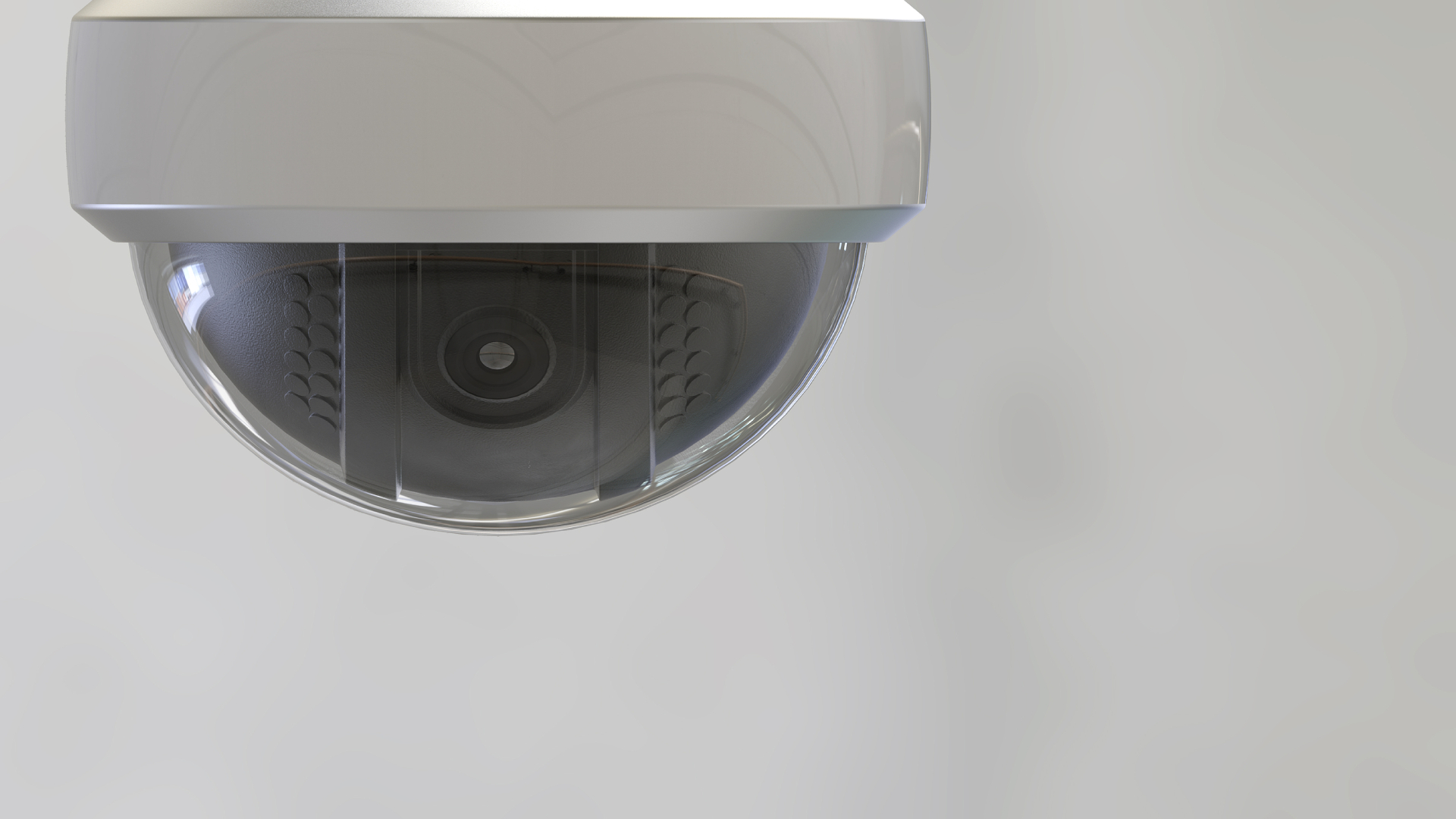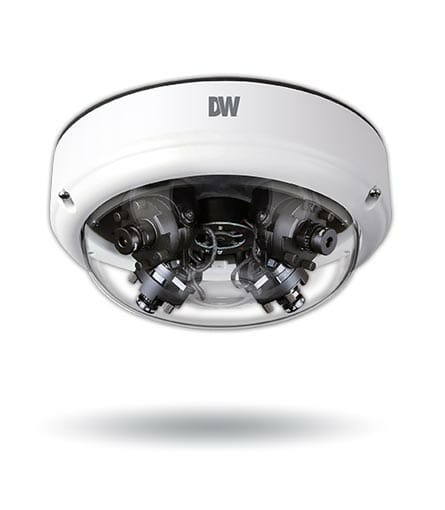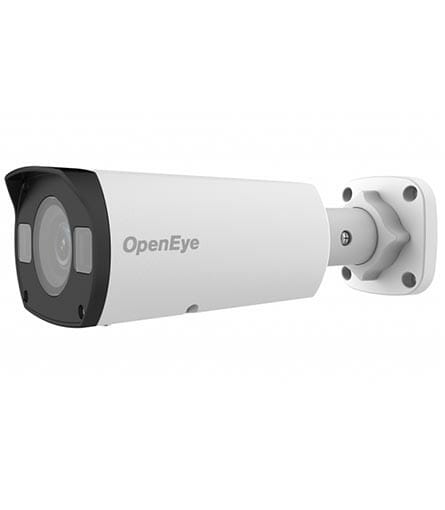
Dome vs. Bullet Security Camera Guide
Selecting the right type of security camera for your home or business is critical, as security cameras are not all the same: different resolutions, different capabilities, and different features.
Currently, there are two common types of security cameras: dome and bullet.
As you might guess, both camera types are named for their shapes. But there are also differences in how these types of cameras function. Read on to get the information you need to decide which is right for you.
Dome Cameras are discreet with wide-angle lenses.
A dome camera is a circular, dome-shaped camera that can sit flush with ceilings and walls. It has a plastic dome that goes over the camera lens, which is typically wide angle.
Camera Placement
When installed, dome cameras are discreet. Installers can recess dome cameras into ceilings or walls or install them on camera poles. The wires get tucked into the back of the camera housing, leaving nothing exposed. One significant advantage of dome cameras is their durability. Many dome cameras are difficult to tamper with or damage, meaning they are essentially “vandal-proof.”

An installer can place dome cameras indoors or outdoors. However, the plastic dome cover is prone to collecting dust and debris—especially when installed outdoors. Dust and debris can block the camera view, so keep this in mind when making your decision.
Camera Size
Camera size will depend on your security needs. Dome cameras come in multiple sizes, with the entire product size depending on the size of the actual camera within the housing. In general, a smaller dome camera will house a smaller camera with a lower resolution. And a larger dome camera will house a larger camera with greater resolution.
With these types of cameras, larger is not necessarily better—even if the resolution is higher. A fisheye camera, which provides a 360° view, typically comes in a smaller package. A 16MP optical zoom camera is much larger, to accommodate the larger camera lens. But these are vastly different cameras, with entirely different functions. It’s best to work with a professional to determine which will meet your needs.
Camera Function
As for function, dome cameras offer a good deal of versatility. Dome cameras have a fixed position, meaning the direction the camera faces is the only direction that the camera can see. However, most dome cameras have a wide-angle lens. Wide-angle lenses capture larger viewing areas than regular lenses. Measured in millimeters (mm), a dome camera’s lens can be anywhere from 1.8mm (wide angle) to 170mm (narrow angle).
Dome cameras offer both digital and optical zoom. In terms of video quality, optical zoom is far superior. Optical zoom dome cameras magnify an image by zooming the actual camera lens in and out—a process that does not alter the image’s original resolution. (An optical zoom lens is also known as a varifocal lens). In contrast, digital zoom cameras do not have an adjustable lens. A digital zoom dome camera stretches video like you would zoom in on a picture on your phone by stretching it with your fingers. Digital zooming enlarges the pixels, which reduces image quality.
Bullet cameras are more visible and capture at longer distances.
A bullet camera is a narrow, cylindrically shaped camera great for both indoor and outdoor use. Because of its features, it’s ideal for capturing people and objects at longer distances.
Camera Placement
When installed outdoors, bullet cameras have some advantages over dome cameras. For instance, they are not as prone to dust and debris blocking the lens.
But bullet cameras do have a few downsides. They slightly protrude from ceilings and walls, making them less discreet when compared to dome cameras.

Installing a bullet camera is straightforward. Bullet cameras come with separate mounting brackets, which make for easy installation. The wires get tucked behind the camera, most often through a small tube connecting to the ceiling or wall. Of course, a professional can also install them.
Camera Size
Bullet cameras come in various sizes. As with dome cameras, camera size depends on resolution. Size can also depend on whether you intend to use the camera outdoors. Some outdoor cameras will come in metal housing to protect them from the weather. More rugged outdoor cameras can also be larger.
Camera Function
Bullet cameras have a fixed position. But once set up , you or a professional agent can easily reposition the camera to change the viewing angle. All it requires is loosening or removing a few screws, repositioning, then retightening the screws. A dome camera does not have this type of flexibility.
If camera range is important, then a bullet camera is likely the solution. Most bullet cameras have a standard angle of view (the opposite of a dome camera). The shape of the bullet camera allows for a larger lens than a dome camera, which results in clearer images at further distances. For a real-world example, look at the cameras on light poles next time you are at an intersection. Some municipalities use license plate recognition bullet cameras at intersections, to capture quality images at a distance. A bullet camera’s lens can be anywhere from 2.88mm to 50mm.
As with dome cameras, a bullet camera can come with either optical or digital zoom.
Is one camera type better than the other?
Let’s face it—there are hundreds of security camera options out there. If you buy one without weighing your needs against the cameras’ features and functions, you could end up with a model that doesn’t adequately protect your home or business.
The best security camera is the one that best suits your needs. How do you decide which one hits that mark? Below are just a few key facts to consider to help make your decision easier. (We also have a guide discussing what to look for in a security camera system. Check it out!)
Dome Camera vs Bullet Camera
| Feature/Benefit | Dome Cameras | Bullet Cameras |
| Lens | Wide-angle lens permits a wider field of view. | Standard angle lens permits a longer field of view. |
| Main benefit | More discreet than other types of security cameras. | Installation and repositioning are easy. |
| Zoom | Both optical and digital zoom available. | Both optical and digital zoom available. |
| Placement | Can be used indoor & outdoor, but the plastic dome cover can become dirty outdoors. | Indoor & outdoor use, without the worry of the lens becoming blocked. |
| Weather Resistance | Weatherproofed for use outdoors. | Weatherproofed for use outdoors. |
| Night Vision | Some models are equipped with infrared night vision. | Some models are equipped with infrared night vision. |
| Durability | Some models are vandalism resistant. |
Bullet and dome security cameras are two of the most common security cameras on the market. They bring great versatility with their many configurations and models. But with so many different cameras to choose from, it can be hard to decide what is best for your home or business. If you still have questions, contact the security experts at Bay Alarm. Our team is ready to help get you the security that fits your needs. Get in touch today!
Start a conversation with a Bay Alarm security expert.
Related Articles
Orange County is a vibrant hub for a wide range of industries, including tourism, entertainment, and... Read More >
Auto dealerships hold expensive inventory and high-value parts and accessories, making them a prime target for... Read More >
Agricultural businesses face a variety of security concerns. They have to protect livestock, expensive machinery, and... Read More >
Preventing theft and inventory shrinkage is crucial for retail and grocery stores already challenged by razor-thin... Read More >
Security guard services offer on-the-ground protection for businesses seeking an additional layer of safety for their... Read More >
The Phoenix metropolitan area continues to experience incredible population growth. With year-round sun, affordable housing, and... Read More >
Office buildings pose a variety of security challenges that businesses must address to safeguard their people,... Read More >
Retail theft is one of the leading causes of business owners’ stress and economic hardships. In... Read More >
Outdoor and remote locations can push traditional surveillance systems to their limits. Fixed systems face challenges... Read More >
From the early 20th century, Los Angeles has been known across the world for its unparalleled... Read More >
Commercial earthquake preparedness is critically important, especially in a city like San Francisco with its long... Read More >
Hospitals face many security challenges, one of which is ensuring proper storage and monitoring of controlled... Read More >
It’s common to think of cybersecurity and physical security as two separate operations. However, in the... Read More >
If you live in California, you are no stranger to the challenges of getting insurance. It’s... Read More >
Fire safety is a priority everywhere, but in California it’s especially urgent. To be prepared, business... Read More >
Protecting educational campuses and facilities is an increasingly urgent and complicated problem. Campus buildings can be... Read More >
Is it time to update your business’s security system, but you’re unsure where to start? We... Read More >
Managing properties, whether one or multiple, means constantly juggling challenges. Dealing with buildings in different cities... Read More >
As security technology advances, so do the options for customizing security protocols. A security protocol tells... Read More >
Live video monitoring is a next-generation security service that combines new technologies in threat detection (way... Read More >
Businesses and people are now using facial recognition technology to make payments, bank online, and as... Read More >
In their research report on “The Future of Physical Security,” execs from Microsoft and Accenture interviewed... Read More >
Customer: Laborers Training School Laborers Training School provides construction-based labor training to union workers in multiple locations... Read More >
As we mentioned in a previous article, several trends in the security market have made live... Read More >
News about artificial intelligence is everywhere these days. So it’s no surprise that business owners are... Read More >
The best runners in the world aren’t simply fast; they’re efficient. The most popular cars don’t... Read More >
What are security GUARD services? Security agent services (SAS) are live security guards who work on... Read More >
A typical customer in 2023 wants—and expects—a shopping experience that works for them. A challenge for... Read More >
There’s no denying that AI-powered technology offers you a chance to step up your business’s security... Read More >
You’ve probably heard of behavioral analytics. It’s everywhere these days, shaping our world and dramatically influencing... Read More >
Understanding who is at your business—and when—is a key priority for most business owners. Another obvious,... Read More >
Video security has come a long way, so much so that the full capabilities of a... Read More >
What is live video monitoring? Live video monitoring is a commercial security service that deters crime... Read More >
According to Security Magazine, more than 2,000 first-responder agencies across the US currently use drones and... Read More >
Scaling a business is an exciting time filled with new possibilities. But it can also bring... Read More >
If you’re relatively handy and feel like you have a solid understanding of technology, you might... Read More >
A video security system is only effective if it’s installed properly. The most advanced, AI-based camera... Read More >
Preserving employee safety can be a big challenge when expanding your business to multiple locations. As... Read More >
According to the National Insurance Crime Bureau, more than one million cars were stolen across the... Read More >
Has a speeding car in the next lane ever distracted you from seeing a pothole until... Read More >
Every business owner deals with risk: it’s part of doing business. Some risks are worth taking,... Read More >
An unsafe work environment poses hazards for businesses beyond the physical risks to employees. It can... Read More >
The best modern business security systems feature some of the most advanced technology on the planet.... Read More >
Build a culture of safety the right way Protecting employees and the office work space takes... Read More >
Warehouses are complex environments that present many potential hazards to employees. According to the Occupational Safety... Read More >
Protect Your Business Without Breaking the Bank Protecting staff, inventory, and physical property is a priority... Read More >
Security tools work best when they fit the exact needs―and capacity―of your business and staff. The... Read More >
Implementing an effective security system for your business isn’t as simple as installing a camera, setting... Read More >
Following business safety regulations isn’t a choice but an obligation. Ignoring compliance standards not only puts... Read More >
Business leaders know how difficult choosing a security system can be. Every organization has specific needs... Read More >
One of the most frequent reasons business owners approach security companies is, unfortunately, one of the... Read More >
Keeping up with trends and technological advancements in the security industry can be challenging. Knowing where... Read More >
Robbery, theft, and arson cost US businesses over $17.2 billion in losses in 2021. As a... Read More >
Searching for a smoke alarm system for your business? You’re probably going to need a smoke... Read More >
Do you know what it takes to stay compliant with building fire codes? Not every business... Read More >
Picture walking from your office building to your car at the end of the day. Others... Read More >
How do you keep up with evolving fire codes for your property? Amid everyday business concerns,... Read More >
Several high-profile fires have raised the urgency of fire protection for cannabis facilities. So, what is... Read More >
If you’re searching for the right video surveillance system, you have likely run across the network... Read More >
Waste is kindling for fires. If you work in the waste industry, you are likely aware... Read More >
The numbers don’t lie. Despite all the focus on cybersecurity, cybercriminals remain a costly threat to... Read More >
School security is important from kindergarten through college. Prioritizing safety can put students and staff at... Read More >
Companies of all industries depend on warehouses to store and ship valuable goods. And storing large... Read More >
As the business owner or manager of a retail store, you need to be aware of... Read More >
As a business leader, you might wonder how to implement or improve the safety program at... Read More >
Video content analysis (VCA), also known as video analytics, is a video surveillance technology used to improve the response to crime and other emergen Read More >
Protecting your business and staff during the holidays can be challenging, especially with all the surrounding... Read More >
Access control systems give business owners and managers the power to control what areas employees and... Read More >
One big reason Bay Alarm is different from other security system companies: it’s locally operated and... Read More >
California voters made recreational cannabis legal in 2016. Since then, thousands of cannabis dispensaries and other cannabis-related businesses... Read More >
The answer is yes, 3G is going away. The network will no longer exist at the end... Read More >
Habitat for Humanity is building a first-of-its-kind 3D-printed home in Tempe, Arizona, as part of their... Read More >
In 2020, owners of some multifamily residences in San Diego began receiving notices titled “Retroactive Residential... Read More >
Here’s some reality TV you probably haven’t seen: actual property crimes in progress, captured by Bay... Read More >
An important part of managing your business is ensuring the safety and security of your employees,... Read More >
Open Supervised Device Protocol (OSDP) is an access control systems standard developed by the Security Industry... Read More >
Contact sensors are security devices typically installed on doors and windows. They can notify you and... Read More >
Standard commercial security guard services include agent response, guard patrol, and standing guard, all of which... Read More >
Biometric security systems digitally identify people through biological signatures, like fingerprints, facial recognition, and eye scans.... Read More >
Ever try scheduling service appointments for multiple locations with a big security company? Chances are, you... Read More >
Having a basic knowledge of burglar alarm systems will help you decide what kind of system... Read More >
Like all security technology, security cameras have come a long way in recent years. As people... Read More >
Your fire alarm and sprinkler systems must satisfy all federal, state, and local regulations. If it... Read More >
Believe it or not, commercial security cameras used to give us blurry images. Luckily, those days... Read More >
Are you hesitant to get a security and fire alarm system for your business due to... Read More >
Fire alarm systems keep buildings and building occupants safe from fires. While it is easy to... Read More >
Catalytic converter theft has become a big issue for car lots as the price of materials... Read More >
An IP camera, or internet protocol camera, is a type of digital security camera that receives... Read More >
When shopping for a business security camera system, you might have the option to choose a... Read More >
Despite advanced security technology, false alarms do happen. Non-emergency events are major strains on local emergency... Read More >
Video alarm verification pairs your security system with an alarm monitoring center. In the event an... Read More >
A motion sensor, or motion detector, is an electronic device that uses a sensor to detect... Read More >
A fire alarm system is one of the most important security features of any building—they are... Read More >
Traditional metal keys can be easily lost, locks must be professionally re-keyed if an ex-employee fails... Read More >
How do you change an employee’s code on your business DMP system? It’s easy! You... Read More >
The ‘Users’ page allows you to manage all of the users on your system. Connect to... Read More >
Schedules and profiles work together to let you customize how and when you give an individual... Read More >
Modern security camera systems are great for monitoring your home or business, as many systems offer... Read More >
The ‘System Overview’ page gives you quick access to the parts of your system you interact... Read More >
For those looking to increase the safety of their home or business, it can be tempting... Read More >
The history page on VirtualKeypad.com allows you to view the most recent events on your system.... Read More >
As a small business owner, you need more than just a security camera or burglar alarm.... Read More >
The reports page allows you to generate reports about what’s been happening on your system. You... Read More >
Holiday dates allow you to adjust your system schedules on special occasions throughout the year. Once... Read More >
The Virtual Keypad website allows you to conveniently manage your access control system using your computer... Read More >
The Bay Alarm Link mobile app makes arming and disarming your business security system easy. Take... Read More >
Adding users to your Business DMP system is easy, and only takes a few steps. To... Read More >
Constructing a new commercial building—be it a retail space, apartment complex, skyscraper, or sporting arena—is a... Read More >
Bay Alarm’s BayGuard+ live video monitoring puts you in complete control of your business’s security system.... Read More >
There are a wide variety of home and business security devices and systems. You can opt... Read More >
Your home or business burglar alarm system increases the safety of everyone and everything within. It’s... Read More >
In 2016, there were over 11,000 reported construction-site equipment thefts in the United States, which accounted... Read More >
A cyber security breach, or data breach, is an intentional or unintentional release of private information... Read More >
The coronavirus pandemic (COVID-19) is shifting most day-to-day work operations from the office to the home.... Read More >
The California State Fire Marshal recently announced that it is still essential for contractors to ensure... Read More >
Fire is one of the top risks to any small business. According to the National Fire Prevention... Read More >
While you can’t always predict supply and demand, ensuring the protection of your business is one... Read More >

